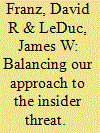| Srl | Item |
| 1 |
ID:
107457


|
|
|
| 2 |
ID:
158224


|
|
|
|
|
| Summary/Abstract |
While the threat from terrorism has gained widespread acknowledgment over the last decade, the infiltration of organizations by “terrorist” insiders has not, and the potential dangers these individuals present has not been fully explored. There is a need to understand the wider aspects of insider threats, including motivations and attack methodologies, and to be able to demonstrate the potential devastation that could be caused. Organizations can attempt to mitigate the potential for insider infiltration by both terrorist and other hostile actors, and if such individuals were within an organization, there are procedures and strategies that can be employed to prevent exploitation of existing organizational vulnerabilities and detection of insiders. This article provides an informed and new approach to the connection between insider threat and terrorism.
|
|
|
|
|
|
|
|
|
|
|
|
|
|
|
|
| 3 |
ID:
175596


|
|
|
|
|
| Summary/Abstract |
The court case concluding in March 2020, involving former Intelligence Community (IC) software engineer Joshua Schulte, was a blunt revelation of the toxic dynamic inside one Central Intelligence Agency (CIA) section. In 2018, Schulte was charged with multiple counts of theft, unauthorized disclosures of classified information, obstruction of justice, and lying to investigators. During his 2020 trial, his management and coworkers’ testimony depicted a work environment marred by bullying, physical violence, vandalism, retaliation, and negligent management framed around one of the most egregious blows to U.S. national security in history. At its most basic level, the organization’s toxicity likely stemmed from unhealthy approaches to wielding, regaining, and managing power. However, the outcome was a tableau vivant of an extremely toxic environment in which personal animosities spiraled out of control and overtook the mission.
|
|
|
|
|
|
|
|
|
|
|
|
|
|
|
|